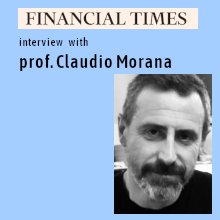In the press
Interview with Professor Claudio Morana in the newspaper "Financial Times"
in "Catastrophe bonds storm into mainstream as climate threat grows" by Ian Smith
Excerpt
The Financial Times interviews CefES Director Claudio Morana and other economists about catastrophe bonds and the climate threat.
Catastrophe bonds storm into mainstream as climate threat grows. Investors take on risks of events like floods and earthquakes in $30bn debt market.
Catastrophe bonds, created in the 1990s as a niche form of risk transfer from insurers to investors, have expanded steadily to a market of more than $30bn in debt outstanding.
According to bankers and insurers, the climate threat is proving a catalyst in what will likely be the second successive year of record issuance.
Climate change is a key factor driving up natural catastrophe losses. While some investors may see climate uncertainty as a great opportunity, Professor Claudio Morana warns against taking that risk. In his opinion, betting against the environment is too hazardous for institutional investors.
The fact that markets have started to appreciate the climate change risk does not mean that markets are currently pricing it correctly!
Have a look at the below figure, which is an update of the one reported in the paper coauthored with Giacomo Sbrana (Neoma Business School)

Source: Artemis https://www.artemis.bm/dashboard/cat_bonds_ils_average_multiple/
The upward trend one would expect, everything else constant, in the average multiple persisted in 2019 and 2020 only, as the multiple reverted to lower figures already in 2021. Meanwhile, radiative forcing (CO2 emissions largely) has continued its expansion, driving the climate risk further upward. This risk is reflected in trend Atlantic hurricane intensity, as well as other disasters associated with excess droughts and floods. For instance, in relation to Atlantic hurricanes, activity has persistently remained above average since 2017, i.e. since 2017 Atlantic hurricane intensity has remained above average over 5 years in a row. Damages were over 50 billion USD in 2018, 2019, 2020, and even larger in 2021 (75 billion USD so far).
Have a look at the performance of a largely non-life investment in insurance-linked securities, reinsurance, and catastrophe bonds index

Source: Artemis https://www.artemis.bm/eurekahedge-ils-advisers-insurance-linked-securities-fund-index/
The recent drops in the index occurred in September 2017 (hurricane Harvey) and November 2018 (hurricane Michael, which made landfall in October). Some recovery can be noted starting in 2019, the least damaging hurricane season since 2017 (12 billion USD) up to September 2020. Thereafter, not surprisingly, the index has stagnated. Damages in 2020 were over 51 billion USD, and over 75 billion USD in 2021 (so far).
Overall, the conclusions in our paper are still valid: betting against the environment is too risky for institutional investors such as pension funds (and not profitable). Hedge funds have the right risk profile for this type of investment. Interestingly, their investment share in this market has fallen over time.
When Giacomo and I wrote this paper, we were worried about pension funds becoming again exposed against junk bonds (as it happened during the subprime financial crisis). In a prolonged period of shrinking opportunities of profitable investment in safe assets as the current one, the risk of purchasing “wrong” assets rises. We then raised our warning.

